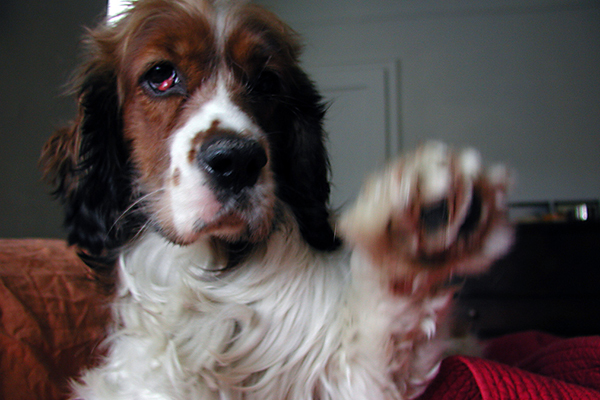Tips on Prevention and Treatment

[ad_1]
If you’re anything like me, your dog is the apple of your eye, and one of the dearest creatures in the world. Your dog’s ocular health may not be the first thing you think of in the morning, but your dog relies on her eyes just as much as you do. Cherry eye in dogs is a condition that doesn’t affect all pups, but can affect any dog’s tear production and eye health.
The signs of cherry eye in dogs are easy to spot; caught and treated quickly, it’s possible to reverse the deleterious effects. In severe cases, though, your veterinarian or a veterinary ophthalmologist may have to perform surgery to prevent long-term eye problems. Let’s talk about cherry eye in dogs and how to treat it!
What is cherry eye in dogs?
All dogs have a third eyelid, also called a nictitating membrane, as well as two glands that produce tears to lubricate their eyes. The nictitating membrane, based in the lower eyelid, is a sort of secondary shield for the eyes. It protects dogs’ eyes from wind, dust, and other foreign objects as they play or work. The nictitating membrane has its own dedicated tear gland. This tear gland produces anywhere from 35 percent to 50 percent of the total moisture in a dog’s eye, and is thus an essential component to overall eye health in dogs.
Cherry eye in dogs occurs when the connective tissue that holds the gland in place is weak, faulty or otherwise damaged. The nictitating membrane’s tear gland comes loose and prolapses from its little pocket and out of the bottom or corner of the dog’s eye, usually closest to the nose. This bulbous, fleshy, red protrusion of the gland from the lower eye is the primary symptom, and gives the condition its colorful, fruited moniker. If your dog has, or has had, cherry eye, you should be especially watchful. Extended or recurring cases of cherry eye in dogs can lead to decreased tear production and other eye problems.
What causes it?
Cherry eye in dogs is a congenital disorder, passed on from generation to generation. Beyond genetic predisposition, it is still unknown what precisely causes it. We do know that the ligaments and connective tissues that hold the tear gland of the nictitating membrane fail to keep it in place, and that cherry eye in dogs is more common in certain breeds.
What breeds are more prone to cherry eye in dogs?
Owners and prospective owners of Basset Hounds, Beagles, Bloodhounds, Boxers, Bulldogs (English and French), Cavalier King Charles Spaniels, Cocker Spaniels, Lhasa Apsos, Neapolitan Mastiffs, Newfoundlands, Pekingese, Poodles (especially Miniature), Pugs, Saint Bernards, Shar-Peis, Shih Tzus, and terriers (including the Boston Terrier, Bull Terrier and West Highland White Terrier) should be aware of the increased risk for cherry eye in these breeds.
Breeds with shorter muzzles, along with toy or teacup varieties in general, are at higher risk for cherry eye in dogs. However, it can happen to any dog, and at any age.
Home treatment for cherry eye in dogs
Caught early enough, I’ve come across many online accounts of successful massage treatment of cherry eye in dogs. Using a combination of a warm, moist cloth and dog-safe eye drops, the home method of treatment involves calming the afflicted dog and gently massaging the prolapsed tear gland of the nictitating membrane until it sucks back into place. Even when this technique is successful, though, there is no guarantee that the cherry eye is gone for good. It may recur, and a dog who has had cherry eye in one eye is at higher risk of having it happen in the other as well.
When to see a vet about cherry eye in dogs
The safest bet with cherry eye in dogs is a visit to the veterinarian, who can accurately determine the specific reason for your dog’s cherry eye. Since there is no fixed cause, an early consultation can help ensure your dog’s long-term eye health.
There are three common surgical options. In the first case, the vet may be able to stitch the prolapsed tear gland back into place. In other cases, a veterinary surgeon may find the connective tissue too weak to cradle the gland properly. For situations like these, the surgeon will attempt to create a new pocket or envelope to hold it in place permanently.
The third option was, in past years, the most common, and involved complete removal of the cherry-eyed tear gland. Removal of the prolapsed gland is an option of absolutely last resort. Removal of the affected tear gland will require lifelong after-treatment with artificial tears to prevent chronic dry eye and secondary problems that can occur when there’s insufficient production of lubrication for a dog’s eyes.
Long-term effects of cherry eye in dogs
Left untreated, a dog with cherry eye is at greater risk for long-term health problems. The longer the gland is prolapsed, the greater the risk of associated problems. Proper blood flow to the gland is restricted. The gland may swell the longer it is exposed. Pawing, scratching or rubbing the affected eye may irritate it further, and create opportunities for secondary bacterial or viral infections to take hold.
In most cases, caught early enough, cherry eye in dogs is successfully treated or managed with minimal veterinary assistance, hopefully before your dog needs surgery.
Thumbnail: Photography ©Flickr user Litherland via Creative Commons License. Some size modifications have been made to fit this site.
This piece was originally published in 2014.
Read Next: When Do Dogs Stop Teething? What to Know About Puppy Teething and Dog Teeth
[ad_2]
Source link






